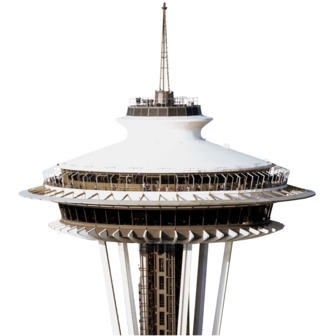Space Needle





Built in 1962, the Space Needle served as the symbol of that year's World's Fair. It has since become the symbol of Seattle, and one of the most recognizable structures in the world. The privately owned Space Needle is managed by Space Needle LLC.
We're always working on improving the Space Needle to make it even more fun and exciting for our visitors. We invite your comments and feedback on your experiences at the Needle.
The story starts on a napkin
In 1959, an unlikely artist inspired by the Stuttgart Tower in Germany was sketching his vision of a dominant central structure for the 1962 Seattle World's Fair on a placemat in a coffee house.
The artist was Edward E. Carlson, then president of Western International Hotels. His space-age image was to be the focus of the futuristic World's Fair in Seattle, whose theme would be Century 21. Carlson penciled the shape that would become the internationally known symbol for Seattle, the Space Needle.
However, Carlson and his supporters soon found moving the symbol from the placemat to the drawing board to the construction phase was not an easy process. The first obstacle was the structure's design. Carlson's initial sketch underwent many transformations. One drawing resembled a tethered balloon and another was a balloon-shaped top house on a central column anchored by cables. Architect John Graham, fresh from his success in designing the world's first shopping mall (Seattle's Northgate), turned the balloon design into a flying saucer. A dozen architects on Graham's team worked on sketches and ideas before a final compromise was reached just a year and a half before the fair was to open.
The next hurdles were location and financing. Since the Space Needle was to be privately financed, it had to be situated on land which could be acquired for public use but built within the fairgrounds. Early investigations indicated such a plot of land did not exist. However, just before the search was abandoned, a suitable 120-foot-by-120-foot piece of land was found and sold to investors for $75,000 in 1961, just 13 months before the World's Fair opening.
Construction, managed by the Howard S. Wright Construction Company, progressed quickly. An underground foundation was poured into a hole 30 feet deep and 120 feet across. It took 467 cement trucks an entire day to fill the hole, the largest continuous concrete pour ever attempted in the West. Once completed, the foundation weighed as much as the Space Needle itself, establishing the center of gravity just above ground.
The five level top house dome was completed with special attention paid to the revolving restaurant level and Observation Deck. The top house was balanced so perfectly that the restaurant rotated with just a one horsepower electric motor. In keeping with the Century 21 theme, the final coats of paint were dubbed Astronaut White for the legs, Orbital Olive for the core, Re-entry Red for the halo and Galaxy Gold for the sunburst and pagoda roof. The 605-foot tall Space Needle was completed in December 1961 and officially opened a mere four months later on the first day of the World's Fair, April 21, 1962.
The Space Needle's elevators were the last pieces to arrive before the opening, the last one just one day before the fair opened. New, computerized elevators were installed in 1993. The elevators travel 10 mph, 14 feet per second, 800 feet per minute, or as fast as a raindrop falls to earth. In fact, a snowflake falls at 3 mph, so in an elevator during a snowstorm it appears to be snowing up.
Storms occasionally force closure of the Space Needle, as they did for the Columbus Day storm of 1962 and the "Inauguration Day" storm of 1993 when winds reached 90 miles per hour. The Needle is built to withstand a wind velocity of 200 miles per hour. The Space Needle has withstood several tremors, too, including a 2001 earthquake measuring 6.8 on the Richter scale. The tallest building west of the Mississippi River when it was built, the Space Needle has double the 1962 building code requirements, enabling the structure to withstand even greater jolts.
The Space Needle was built for just $4.5 million, and has had its share of milestones, including numerous weddings and a jump by six parachutists. During the World's Fair, nearly 20,000 people a day traveled to the top. The Space Needle hosted over 2.3 million visitors during the Fair and is still, over 40 years later, Seattle's number one tourist destination.
In 2000, the Space Needle completed a $20 million revitalization. The year-long project included construction of the Pavilion Level, SpaceBase retail store, SkyCity restaurant, O Deck overhaul, exterior lighting additions, Legacy Light installations, exterior painting and more.
Explore Related Categories







